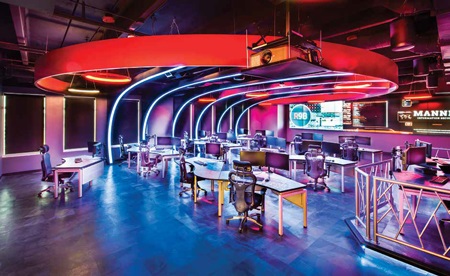Emerging markets, fluctuating oil and gas prices, and more and more spaces within facilities for technology to fit into are some of the factors taking hold as AV integrators across the country gear up for positive numbers in 2016.
Despite some disappointments here and there, most contractors reported an optimistic outlook for 2016 as we took the temperature in various regions throughout the country.
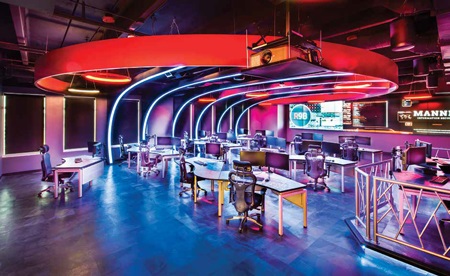
Linx Multimedia recently worked on a project at Root9B, a leading provider of Cybersecurity and Regulatory Risk Mitigation solutions headquartered in Colorado Springs, CO.A Taste of the Big Apple: The Northeast
It’s no secret that New York is booming right now, and as one of the few AV integrators headquartered in Manhattan, Presentation Products gets to witness that boom firsthand, reported the company’s president, Orin Knopp. “Much as they are across the country, tech startups and web firms are leading the charge. Young companies move more often than established ones do, so we’re seeing lots of startups expand into new office spaces. Newer, hip companies tend to place a priority on AV as well.”
While all this movement has led to a dramatic increase in sales for Presentation Products, it’s also brought with it a large increase in cost, he added. “Rents, for example, are at an all-time high. So despite our increasing sales numbers, the business climate remains a high-pressure one.”
New York is doing extremely well for itself right now, with many jobs in the city available. “Businesses are spending, which is a good thing for AV,” Knopp explained. “When the economy is down, it tends to be one of the first areas of expenditure that gets cut. However, with rents at that all-time high, we pay, for example, $40 per square foot for warehouse space which is, no doubt, an exponentially higher figure than most of our competitors in other markets.”
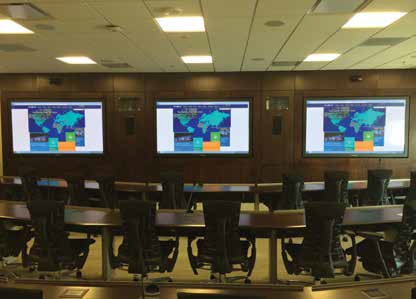
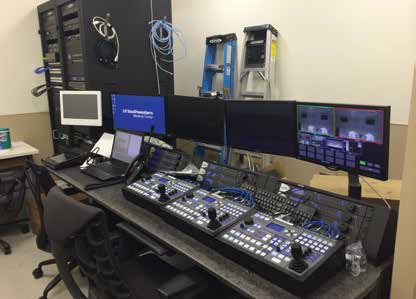
AVI-SPL was charged to build out the AV systems for the University of Texas Southwestern Medical Center’s new hospital. As far as strong markets, the finance market is a lion that is always active, he stated. “Technology, advertising, and media are right at the top—with advertising in particular a big one for us in 2015.”
The legal market, however, proved to be a 2015 disappointment. “There just doesn’t seem to be a big emphasis on AV in law,” Knopp explained. “The luxury goods market was a pleasant surprise for us this past year; luxury goods are a true staple of New York, and the market is ripe for some surprisingly exciting AV designs. The high-end hotel space, also a big market here, was strong as well.”
Presentation Products is most looking forward to the continued growth of the technology, advertising, and media markets in 2016. “These companies understand technology, which can make them a true pleasure to work with,” he added. “And their appetite for exciting AV designs and applications can be insatiable. That’s not to say, however, that the same sentence can’t be applied to certain organizations in every market. This excitement is paired with a sense of urgency brought on by the increased costs. Beyond just rent, higher HR-related costs (employee pay and employee benefits), and continual downward pressure on hardware, margins continue to steeply augment the cost of business. So, the goal is to increase our sales numbers by a higher number than that increased cost. We’re very excited to meet that goal once again in 2016.”
Due West, True North: The Pacific Northwest
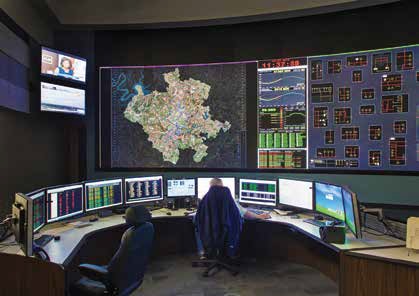
AVI-SPL helped install a new control center for Austin Energy in Texas. The economic climate in the Pacific Northwest was a roller coaster ride in 2010, but has increased overall in every area industry since, said Deborah Klein, Compview’s general manager for Washington. “This includes markets such as corporate, higher education, and healthcare, which are all now investing (or reinvesting) in AV technology and setting new trends for their usage.”
With the growth of Amazon, Airbnb, and the continued success of Microsoft, Boeing, Nike, and Intel, the regional economy has a high employment rate and strong economy that surpasses the national numbers, she stated. “With many companies opening satellite offices in the Northwest due to the local talent pool and slightly lower cost of living, our growth seems to continue. This boom will ultimately slow down, and we believe that growth rates will be at the same level as the rest of the nation within a year or two.”
“Our rising reputation for delivering on time, on budget, and with a high level of customer satisfaction was a verification that we are working smartly, efficiently, and are listening to our clients,” Klein said. “Disappointments came by not being able to deliver the technology exactly as envisioned due to obstacles outside our integration control. A small number of products did not perform as expected, but other AV products are always being introduced and offer solutions to our clients.”
AV trends such as collaboration, open workspaces, distance learning, digital standardization, remote monitoring, and scheduling are all needs that are shared regardless of industry, she concluded. “We look forward to taking these new solutions to our current and future customers.”
Where the Cacti Grow: The Southwest
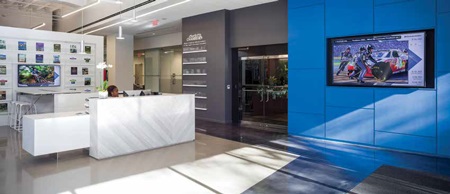
Atlanta-based Technical Innovation worked on an installation recently in the lobby of the Charlotte Chamber of Commerce building. Lance Bowers, senior vice president of operations, AVISPL, reported that the business climate today in the Southwest region is very healthy. “Office building growth continues to steadily increase and the same goes for rental spaces. This is due, in large part, to emerging markets in the Southwest, and our regional team is doing a fantastic job finding these verticals on the rise.”
Like most global businesses, the company is affected by the world economy, so the downturn in energy and oil, for example, causes an impact locally. “With that said, while some capital projects in 2015 have been put on hold, we are seeing a significant uptick in ‘refresh’ projects,” he said. “With huge advancements in technology in such a short time, companies needed to update their systems to attract today’s clients, as well as the top talent in the industry. Collaboration and convenience mixed with the “wow” factor are now the norm for the modern workplace, and organizations are adjusting accordingly.

Technical Innovation helped install a new AV system for the Intercontinental Exchange. Disappointments for 2015 came in the form of market downturns in once-relied-upon sectors, Bowers acknowledged. “I’d say we were ‘somewhat’ disappointed because we’d been expecting this; 2015 was the year when it finally happened. However, with one door closing many more have opened. We trusted our research and found great success in several emerging markets. And the surprise of the year for us was the amount of ‘refresh projects’ we performed. It is always a big part of our business, but in 2015, we saw a dramatic upturn, and we were able to benefit immensely.”
The company is just scratching the surface with emerging markets, he added. “This includes verticals we have already penetrated, as well as other clients who are starting to recognize the need for modernization and collaboration solutions. Knowing the abundance of options we have excites us. With our entire company adopting this philosophy, and our focus on innovation, we expect to carry the momentum of last year into 2016 and beyond.”
Into the Rockies: West
The overall business climate here is strong with a stable recovery, reported Travis Deatherage, president, Linx Multimedia. “The recovery and construction leveled off in mid to late 2015, although there does still appear to be a good amount of opportunity and business investment happening in 2016. The business climate helped to sustain strong population growth of an estimated 1.7 percent in the Denver area for 2015.”
One factor that had a big impact on the region for 2015 was the reduction in the price of oil. “This put a near halt to the massive expansion in growth of the oil industry in Colorado and Wyoming in 2015,” he explained. “There were a number of oil and gas companies restructuring, as well as buying and selling assets to manage what is expected to be a sustained lower level of oil prices. Growth in industries such as residential construction, healthcare, and higher education has helped to offset the slowdown in the oil and gas industry. This slowdown also freed up some labor resources, but those are in tight supply across the construction industry.”
Deatherage was surprised that the oil price downturn has been sustained rather than being just a dip and rebound. “It was nice to see that the regional economy was strong enough that the oil and gas slowdown did not cause an immediate recession across the entire region. 2016 looks to be a steady year of growth at a sustainable level. Companies appear to be investing in resources and space, which bodes well for the economy, but not at an irrational rate. I think everyone is cautiously optimistic that this growth will continue for the next year, but unsure about the sustainability of the economy looking into 2017 and 2018.”
The Heartland: Upper Midwest
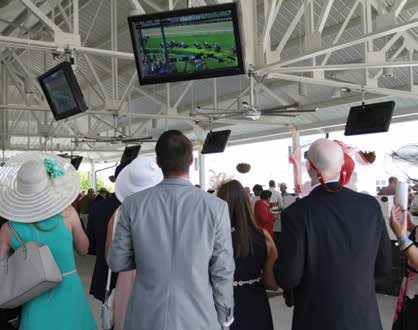
Compview recently worked on an install at Churchill Downs. We would describe the AV business climate in this region as cautiously optimistic, said Scott Tronson, marketing manager, Alpha Video. “We have found that our clients are cautiously spending more for integrated communication systems as the economic condition has improved, but they are not going on an extravagant spending spree for AV technology.”
The strongest markets in this region have been corporate, healthcare, and sports, he reported. “Corporate, because of the number of Fortune 1000 companies headquartered in Minnesota; healthcare, since several major healthcare organizations are headquartered in this region, including the Mayo Clinic, United Healthcare, and Sanford Healthcare; and sports, due to a number significant construction projects for professional and college sports teams, including the Minnesota Vikings, Green Bay Packers, University of Minnesota, University of Iowa, and University of Nebraska.”
One pleasant surprise for Alpha Video has been its CastNET digital signage division, added Jerry Gale, Alpha Video marketing. “We have been selling digital signage systems for almost 20 years, and we were one of the first AV integrators to dedicate a team to selling digital signs. 2015 was the biggest year for digital signage systems.”
One minor disappointment, Gale added, has been in the broadcast market. “The broadcast market is a unique animal; it had explosive growth for several years while TV stations converted from SD to HD video. Now that the major TV stations have made the conversion, sales have leveled off to upgrades and enhancements.”
Alpha is looking forward to continued demand for digital signage systems for all markets and collaborative communication systems for corporations and the education market. “Both professionally and as football fans, we’re really looking forward to integrating the video and broadcast systems in the Minnesota Vikings new US Bank Stadium,” he noted. “Our integration team will be onsite at the stadium throughout the first half of 2016 to make sure everything is ready for the first game in the fall. Other than the Vikings stadium, we see continued demand from the sports market in 2016.”
Into the Southland: The Southeast
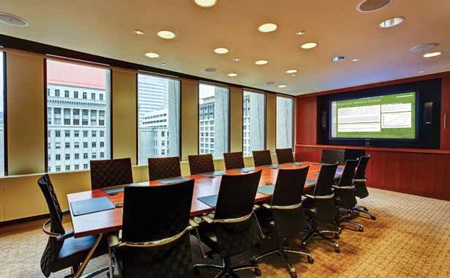
Deborah Klein, Compview’s general manager for Washington, said the economic climate in the Pacific Northwest was a roller coaster ride in 2010, but has increased overall in every area industry since. Shown here is a recent project by Compview. In the Southeast, it’s all still positive and trending in the right direction with technology driving implementation. “But let’s face it,” said Mike Landrum, CEO, Technical Innovation, “development drives our greatest success. Corporations are relocating here, universities expanding, and the DOD is moving to key strategic locations in our region.”
Atlanta maintains its attractive footprint, he added, with Raleigh, NC as a very attractive locale for employers, and Birmingham, AL as one of Technical Innovation’s fastest growing areas, encompassing the Florida Panhandle area and crossing over into Jackson, MS.
“We have launched three new offices: in Houston, in the National Capital Region, and in New York City,” he noted. “We launched in the NCR first, and that has gained some nice momentum already.”
Part of Technical Innovation’s success story is about diversity of industries, of technologies, and markets, Landrum said. “Our expansive specializations and adjacent technologies are attractive to our clients. Our three business units, in particular, realized substantial growth: Presentation Technology Solutions, Broadcast Solutions Group, and Critical Space Solutions, with the last two of these functioning with a national presence. And Atlanta was one of our strongest offices for growth in 2015. Overall, we grew 26.3 percent in 2015.”
Regarding the federal market, it is now more difficult for an AV company to differentiate itself as a high-value solutions provider. “Contracting is more price sensitive than ever, and our federal business was disappointing last year. On the plus side, we’ve grown into a staff of 470 high-quality people to keep our high standards of customer service alive and to ensure good repeat business.”
Looking to 2016, Landrum noted that a big part of what’s driving the current industry is architectural considerations for new office spaces. “Every surface has the potential for technology, and the number of these places within organizations today has grown by leaps and bounds, driven by architects and by employers who are trying to attract the best talent by empowering them with great technology. This applies to corporate spaces and to universities. The DOD is highly focused on effective tools to empower them as well. Given all that, we expect to grow about 10 percent this year.”
Karen Mitchell is a freelance writer based in Boulder, CO.
